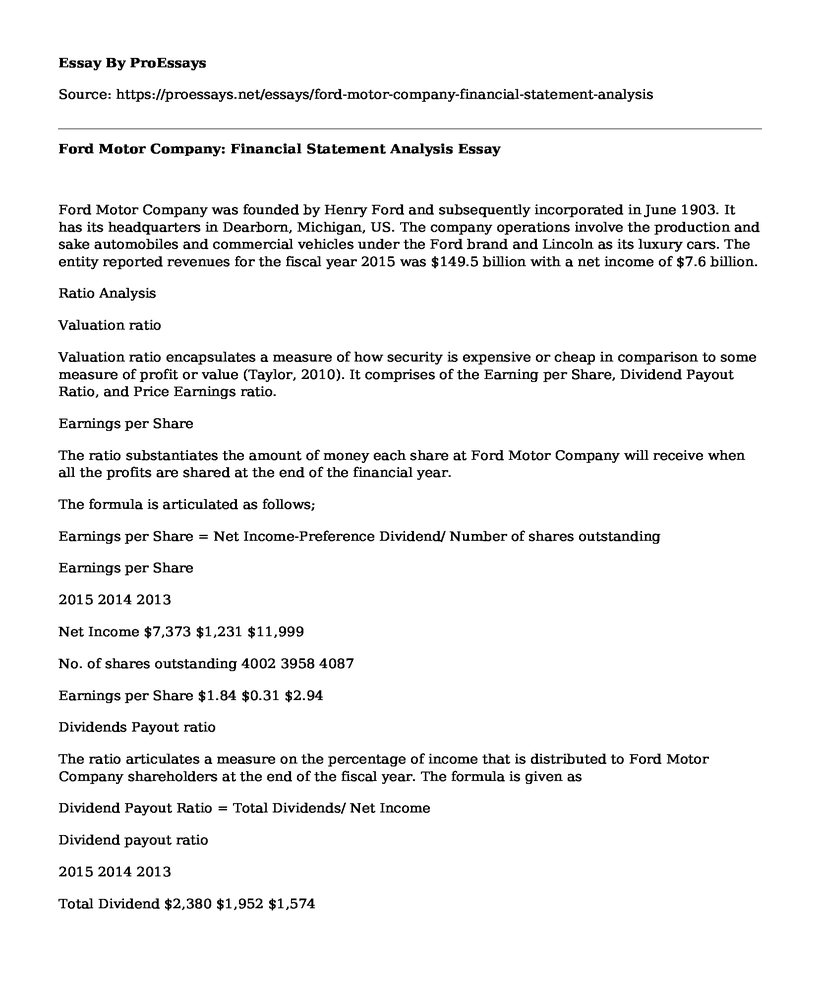Ford Motor Company was founded by Henry Ford and subsequently incorporated in June 1903. It has its headquarters in Dearborn, Michigan, US. The company operations involve the production and sake automobiles and commercial vehicles under the Ford brand and Lincoln as its luxury cars. The entity reported revenues for the fiscal year 2015 was $149.5 billion with a net income of $7.6 billion.
Ratio Analysis
Valuation ratio
Valuation ratio encapsulates a measure of how security is expensive or cheap in comparison to some measure of profit or value (Taylor, 2010). It comprises of the Earning per Share, Dividend Payout Ratio, and Price Earnings ratio.
Earnings per Share
The ratio substantiates the amount of money each share at Ford Motor Company will receive when all the profits are shared at the end of the financial year.
The formula is articulated as follows;
Earnings per Share = Net Income-Preference Dividend/ Number of shares outstanding
Earnings per Share
2015 2014 2013
Net Income $7,373 $1,231 $11,999
No. of shares outstanding 4002 3958 4087
Earnings per Share $1.84 $0.31 $2.94
Dividends Payout ratio
The ratio articulates a measure on the percentage of income that is distributed to Ford Motor Company shareholders at the end of the fiscal year. The formula is given as
Dividend Payout Ratio = Total Dividends/ Net Income
Dividend payout ratio
2015 2014 2013
Total Dividend $2,380 $1,952 $1,574
Net Income $7,373 $1,231 $11,999
Dividend payout ratio 0.32 1.59 0.13
Dividend per Share
The ratio substantiates the total declared dividends paid on a one share basis to the ordinary shareholders of the company.
Dividend per Share = Total Dividend/ No. of shares outstanding
Dividend per Share
2015 2014 2013
Total Dividend $2,380 $1,952 $1,574
No. of shares outstanding 4002 3958 4087
Dividend per Share $0.59 $0.49 $0.39
Profitability ratio
The ratio articulates how well Ford Motor Company achieves its profit from the operation. The ratio consists of the profit margin, the return on assets and the return on equity
Profit margin
The ratio encompasses the amount of net income that is substantively generated with each dollar of sale that Ford Motor Company generated in the fiscal year. The formula for the ratio is described as
Profit Margin Ratio = Net Income/ Net Sales
Profit margin
2015 2014 2013
Net Income $7,373 $1,231 $11,999
Net sales $140,566 $135,782 $139,369
Profit margin 5% 1% 9%
Return on Assets
The ratio pragmatically accentuates the efficiency in which Ford Motor Company assets produce the profits in a given accounting period. The formula is derived as
Return on assets ratio = Net Income/ Average Total Assets
Return on Assets
2015 2014 2013
Net Income $7,373 $1,231 $11,999
Average Total assets $216,770 $205,397 $196,698.5
Return on Assets 3% 1% 6%
Return on Equity
The ratio substantiates a measure of the Ford Motor Company's ability to generate profits from funds invested by the shareholders (ROMIC, 2011). The formula is described using
Return on Equity = Net Income/ Shareholder Equity
Return on Equity
2015 2014 2013
Net Income $7,373 $1,231 $11,999
Shareholders Equity $28,657 $24,465 $26,112
Return on Equity 26% 5% 46%
Liquidity Ratio
The ratio substantively analyzes Ford Motor Company's ability settling the current liabilities as they become due and the long-term liabilities as they convert to current. The ratio includes quick ratio, current ratio and times interest earned ratio.
Quick ratio
The ratio accentuates a measure of Ford Motor Company capability in paying the short term obligations using the quick assets that can be converted within 90 days. The formula encompasses
Quick ratio = Cash & Cash Equivalent + Short-term investments+ Current receivable/ Current Liabilities
Quick ratio
2015 2014 2013
Quick assets $23,567 $21,702 $25,116
Current liabilities $39,656 $40,108 $37,003
Quick ratio 0.59 0.54 0.68
Current ratio
The ratio describes a measure of Ford Motor Company capacity to pay the short-term liabilities with the current assets. The formula encapsulates
Current ratio= Current Assets/ Current Liabilities
Current ratio
2015 2014 2013
Current assets $42,574 $38,758 $42,457
Current liabilities $39,656 $40,108 $37,003
Current ratio 1.07 0.97 1.15
Times interest earned ratio
The ratio substantiates a measure of the proportionate income amounts that Ford Motor Company uses to cover the interest expenses. The formulae are derived as
Times Interest Earned ratio= EBIT/ Interest Expense
Times interest earned
2015 2014 2013
EBIT $13,479 $4,730 $18,060
Interest expense $3,227 $3,496 $3,689
Times interest earned 4.18 1.35 4.90
The ratios calculated provide an analysis on Ford Motor Company valuation, profitability and its financial strength (Soffer, 2003). The company is a good investment to the shareholders because it offers a return in the form of dividends paid over the three financial years.
References
ROMIC, L. (2011). FINANCIAL STATEMENT ANALYSIS. International Journal of Management Cases.
Soffer, L. C. ( 2003). Financial statement analysis: A valuation approach. Pearson College Division.
Taylor, M. (2010). Financial statement analysis.
Cite this page
Ford Motor Company: Financial Statement Analysis. (2021, Mar 13). Retrieved from https://proessays.net/essays/ford-motor-company-financial-statement-analysis
If you are the original author of this essay and no longer wish to have it published on the ProEssays website, please click below to request its removal:
- Insurance Essay Sample: Moral Hazard
- Liquidity Analysis for Apple Paper Example
- Health Insurance and Managed Care Paper Example
- Expansionary Fiscal Policy Essay Example
- Essay Sample on Political Theory and Budget
- Accounting Fraud at WolrdCom Case Study Paper Example
- Essay Example on Mutual Funds: Investing in Bonds, Stocks & More







